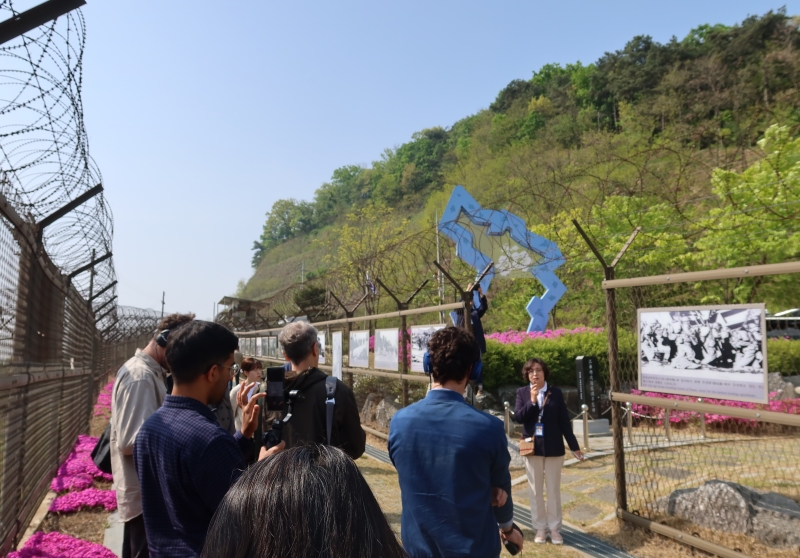
Foreign news correspondents on a media tour of DMZ Peace Trail on April 27 listen to an explanation at 6.25 Veterans Memorial Park in the town of Ganghwa-eup in Incheon's Ganghwa-gun County. (Kim Hyelin)
By Kim Hyelin
Ganghwado Island, Incheon
Seven foreign correspondents from the U.S., Japan, U.K., China and France on April 27 at 9:30 a.m. gathered at 6.25 Veterans Memorial Park in Ganghwa-gun County of Incheon to go on a media tour of the newly opened DMZ (Demilitarized Zone) Peace Trail.
The trail was initially opened in 2019 to commemorate the first anniversary of the inter-Korean summit of April 27, 2018. Ten regions nationwide bordering the DMZ offer 11 themed tours, and Korea.net on April 27 went on one of them to explore the main areas.
Located in the country's northwestern region, Ganghwado is about 60 km or a 90-minute drive from Seoul. The northern coastline forms the southern limit of the inter-Korean border, and the island has historically been a strategic military location because it is at sea and close to Seoul.
The armistice agreement signed on July 27, 1953, stipulates a 2 km-wide buffer zone on each side of the Military Demarcation Line. The DMZ is usually in inter-Korean territory with barbed wire marking the boundaries. Ganghwado is on the trail despite not being on the mainland because it straddles the DMZ on water.
Its official name is "Neutral Waters of the Hangang River Estuary" (unofficial translation). The 67-km waterway runs from Paju, Gyeonggi-do Province, to Ganghwa-gun and borders North Korea to the north. The armistice allows private ships to use the estuary but both Koreas have banned this given the risk of armed conflict.
A source from the Republic of Korea Marine Corps said this region is managed at the same level as the DMZ on land.
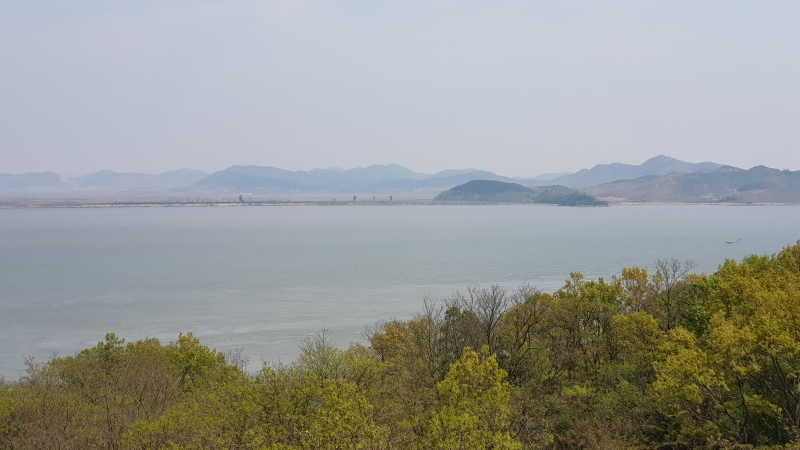
This view of the Hangang River estuary and North Korea is from Ganghwa Peace Observatory in Ganghwa-gun County of Incheon. (Kim Hyelin)
The mannequin of an armed soldier stood out at the entrance of the memorial park, where the tour began. A replica of a two-story guard post appeared, with a barbed wire fence continuing to the right, and to the left was an exhibition of photos taken during the Korean War (1950-53) displayed in chronological order to show the situation at the time.
At 10 a.m., the bus stopped at the entrance to the village of Cheolsan-ri in Yangsamyeon Township. A Marine staff member boarded the bus at the entrance to the Civilian Control Zone and checked the ID of each foreign correspondent.
Taking photos is prohibited along the coastlines with the barbed wire fence for security reasons. Each correspondent received a neon yellow jacket and binoculars and headed to a dondae, a Joseon Dynasty fort in border areas made with dirt and stones.
A climb along the stone walls of the fort featured a panoramic view of the North Korean village of Samdal-ri across the river. The view was unclear due to fine dust but Songaksan Mountain in Gaesong was visible from a distance.
All of the correspondents used their binoculars to see North Korea, which appeared seamless, blue and peaceful through their lenses. The distance to the North was 2.3 km, too close for a place to be considered off-limits.
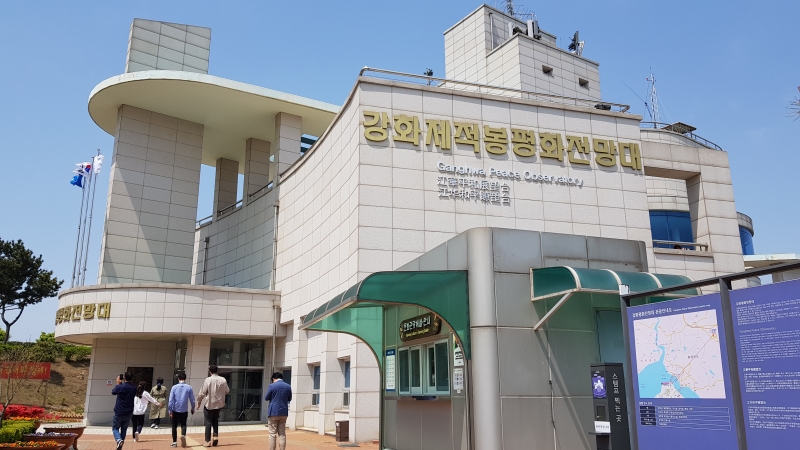
Rising 118 m high, Ganghwa Peace Observatory in the village of Cheolsan-ri in Yangsanmyeon Township of Incheon's Ganghwa-gun County is the island's northernmost point, from where North Korea seems closer. (Kim Hyelin)
The group arrived at Ganghwa Peace Observatory around 1 p.m. All sides of the structure's third floor were covered with windows to offer a panoramic view. The correspondents listened to a brief history of the island and the North Korean village seen from the observatory and watched a related video.
"Displaced people who left their loved ones behind come here for an even closer look at the land up north," the narration said.
Around 3 p.m., the group headed toward Gyodongdo Daeryong Market on Gyodongdo Island. Northwest of Ganghwado, Gyodongdo is a front-line island facing Yeonbaek-gun County of North Korea's Hwanghae-do Province over a narrow sea. The market started after Korean War refugees opened stalls to make a living.
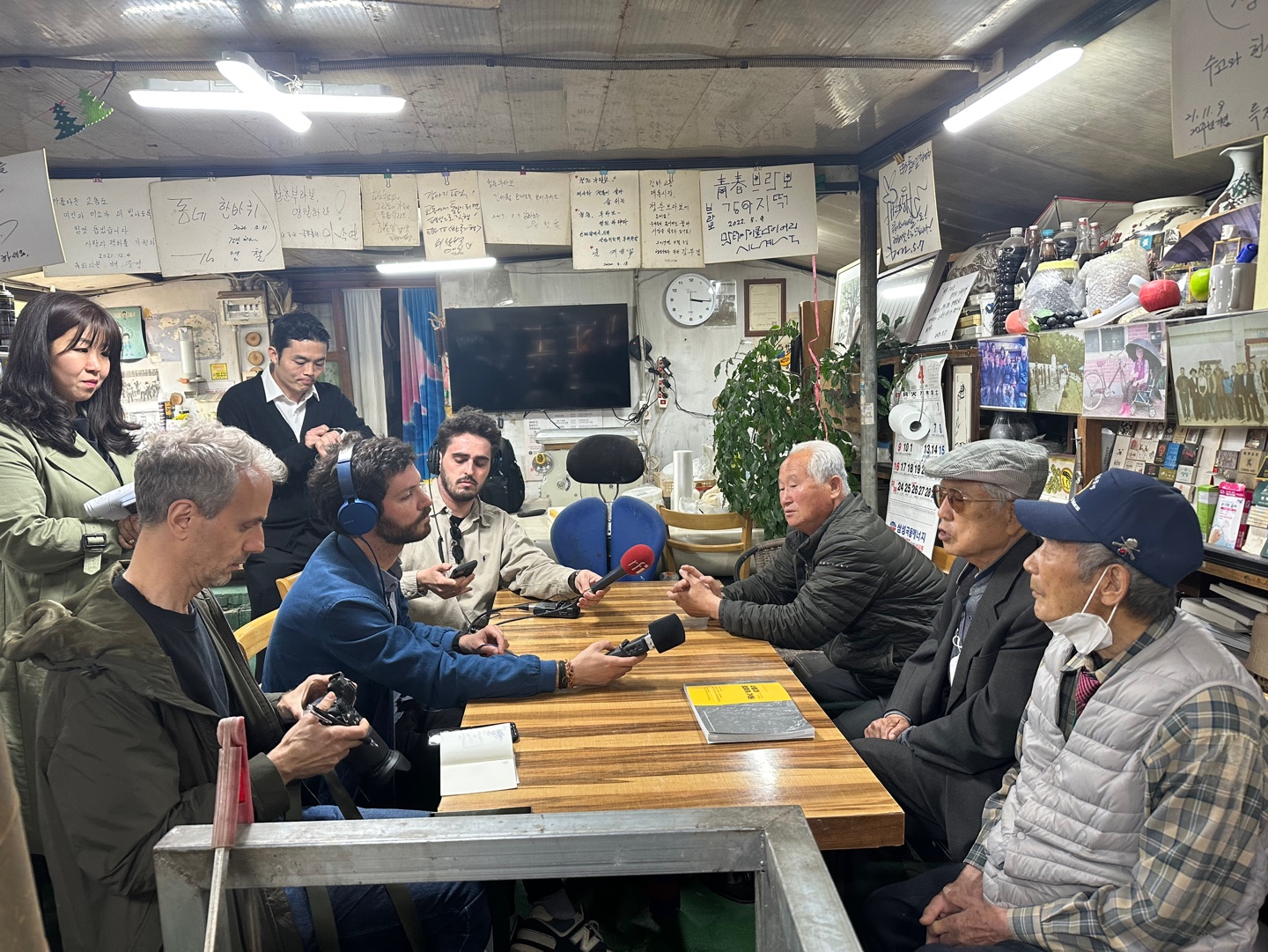
Foreign correspondents on a media tour of the DMZ Peace Trail on April 27 interview residents of Gyodongdo Island. (Ganghwa-gun County Office).
"About 30,000 refugees came here when the war broke out but had no place to sleep, so they just entered any house. Residents who had spare rooms shared them and if they didn't, they adjusted cattle barns to create room there," Gyodongdo resident Bang Jae-hee said.
Choi Bong-yeol, a first-generation refugee from North Korea who boarded a wooden boat at age 19 to flee, said, "Now, people who came as refugees and settled here are just like locals," adding, "My life is here on Gyodongdo Island and I want to stay until I die because life is peaceful here."
Nicolas Rocca from Radio France Internationale said he was surprised that the number of North Korean defectors living in Korea is similar to that of Gyodongdo residents, adding that this is a touching story from history that he did not know.
The tour finished with a close-up view of North Korea and the group left the island around 4 p.m. Through this and other similar tours, the younger generation, despite not directly experiencing the war and learning about it from books, can feel the reality of the conflict and the divided Korean Peninsula.
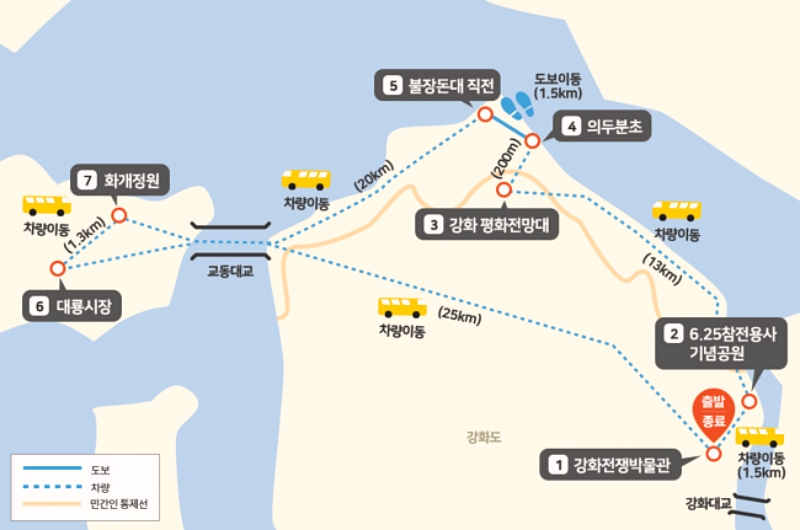
Ganghwa DMZ Peace Trail spans 63 km and covers the following sites: Ganghwa War Museum, 6.25 Veterans Memorial Park, Ganghwa Peace Observatory, Euidubuncho, Gyodongdo Daeryong Market and Hwagae Garden. The tour runs Thursday to Sunday daily until Nov. 30. Reservations are available on the trail's official website (www.durunubi.kr/dmz-main.do) and the fee is KRW 10,000 per person. (Screen capture from trail's official website)
kimhyelin211@korea.kr